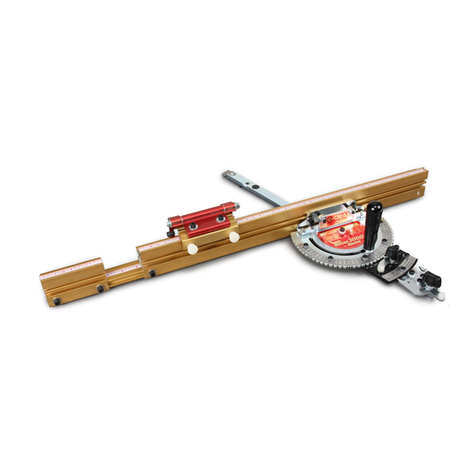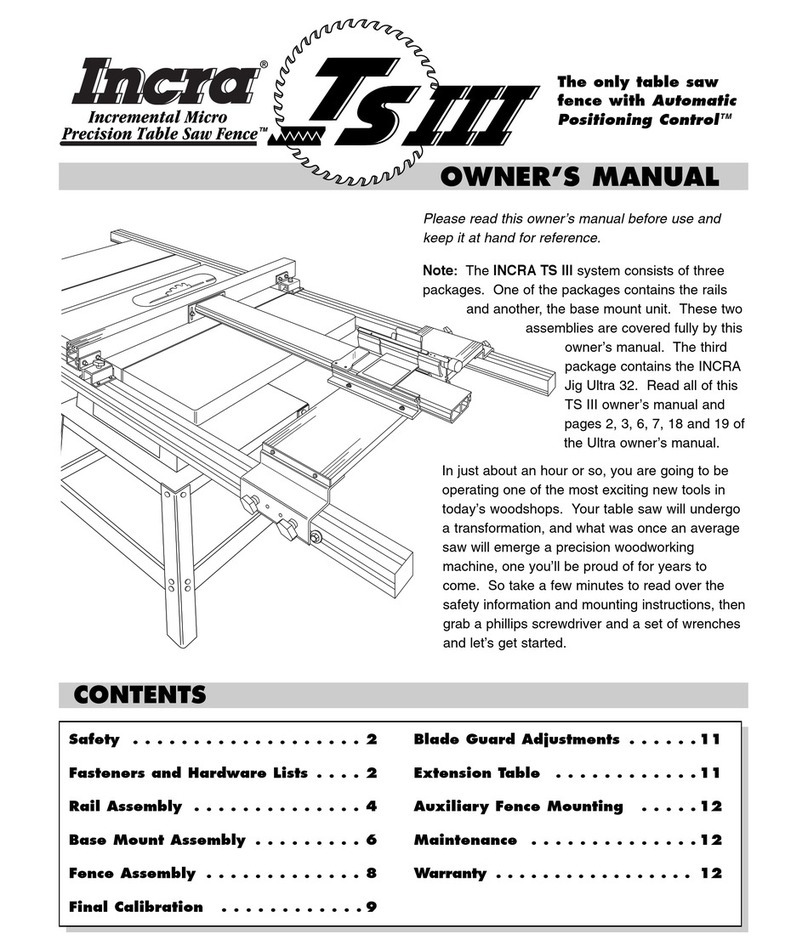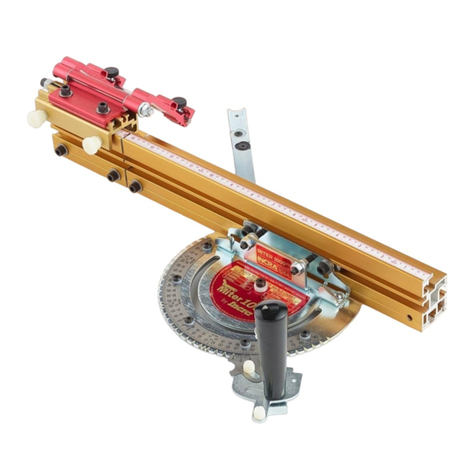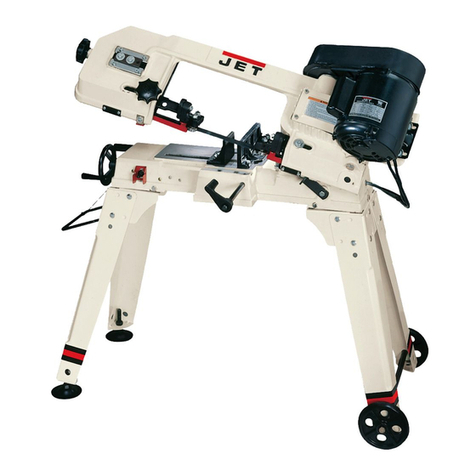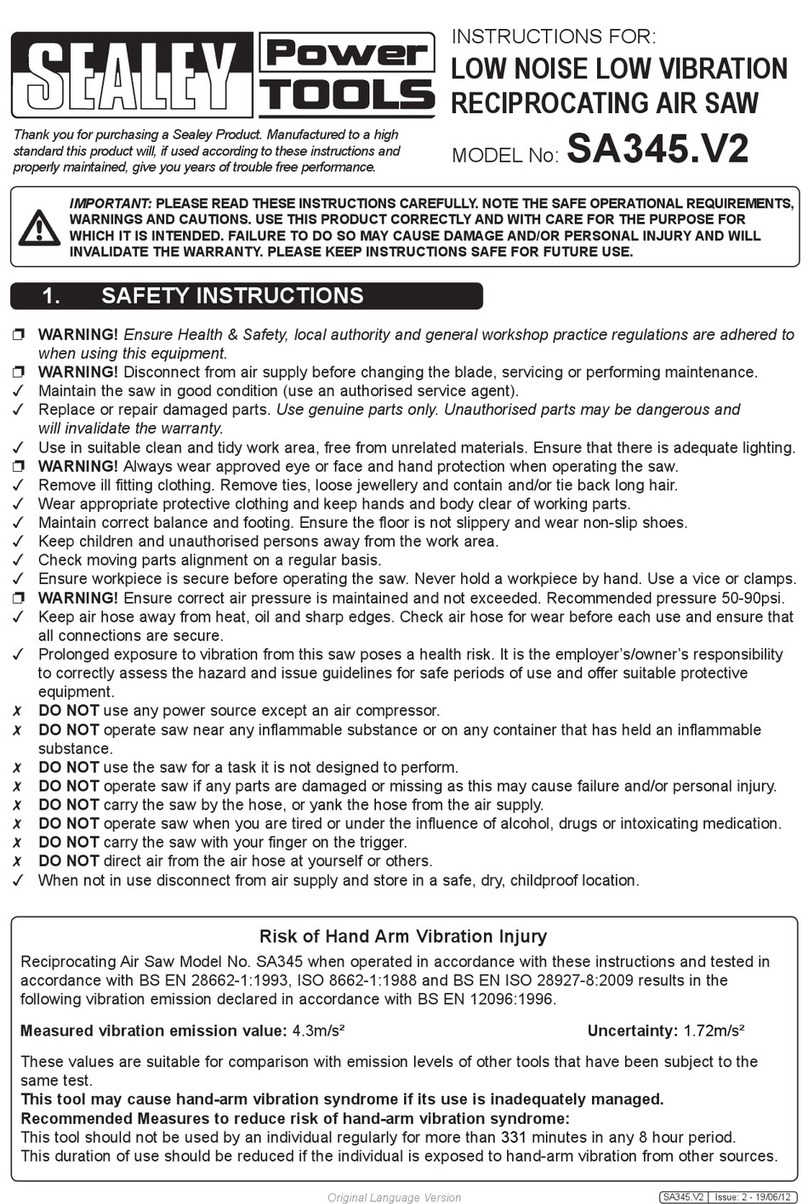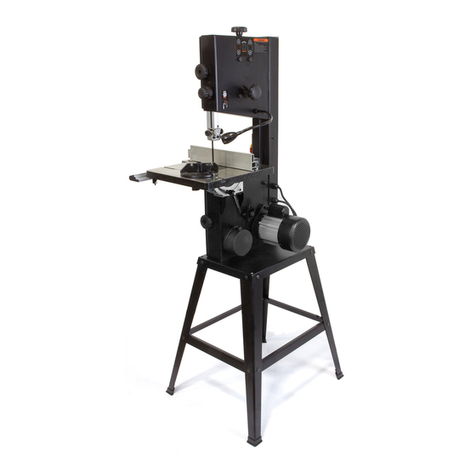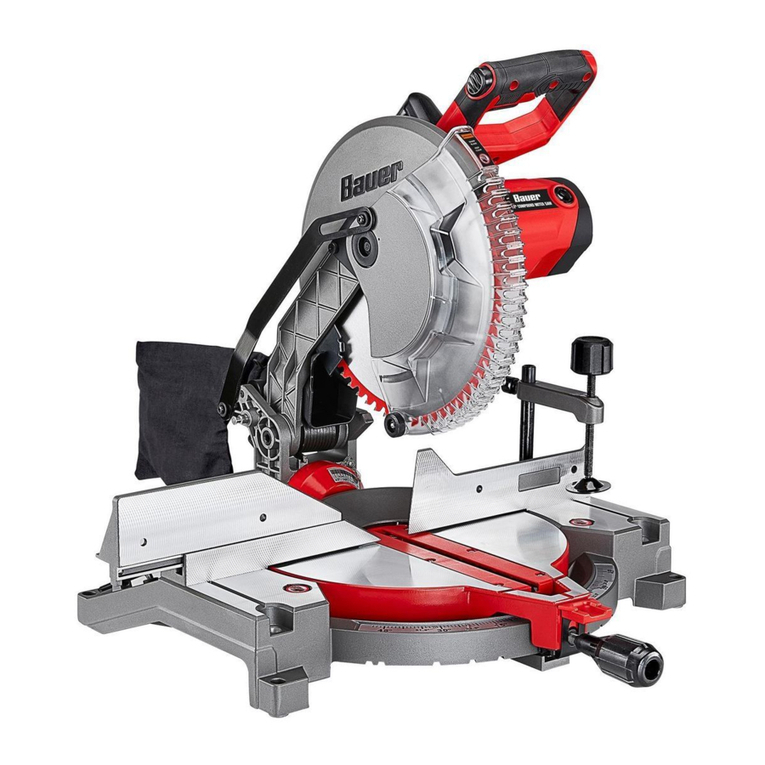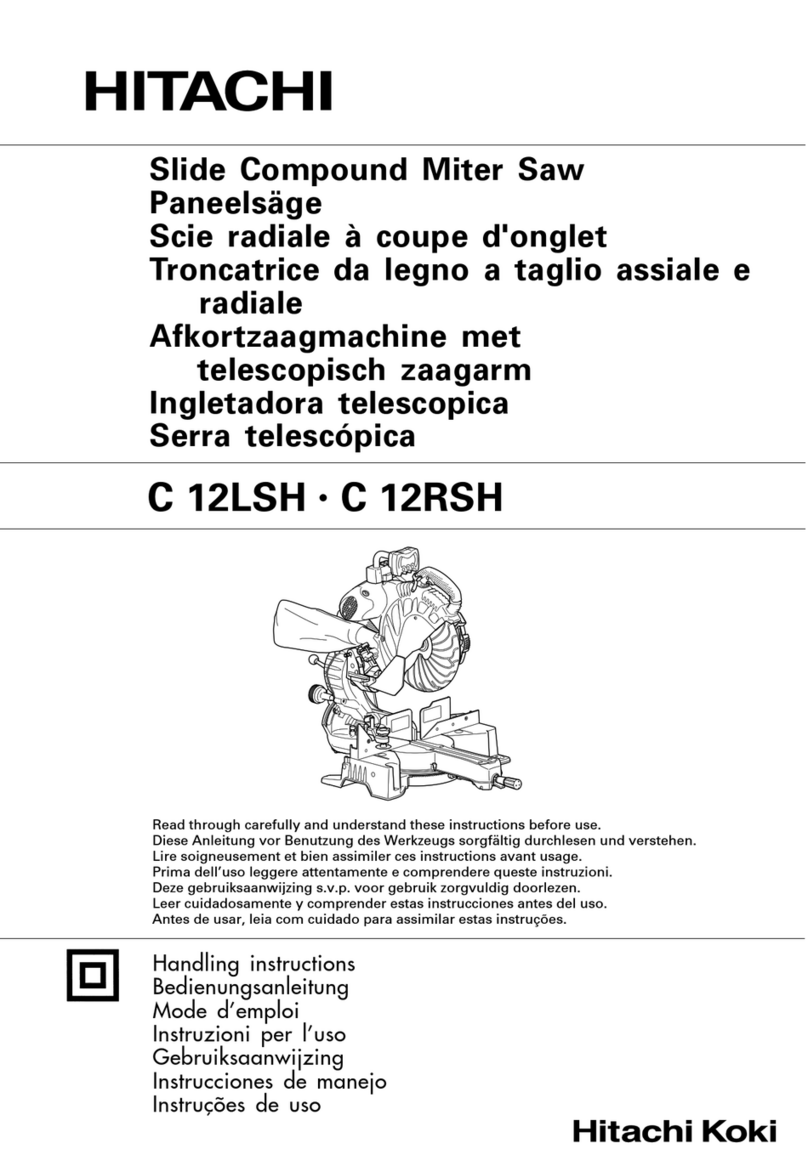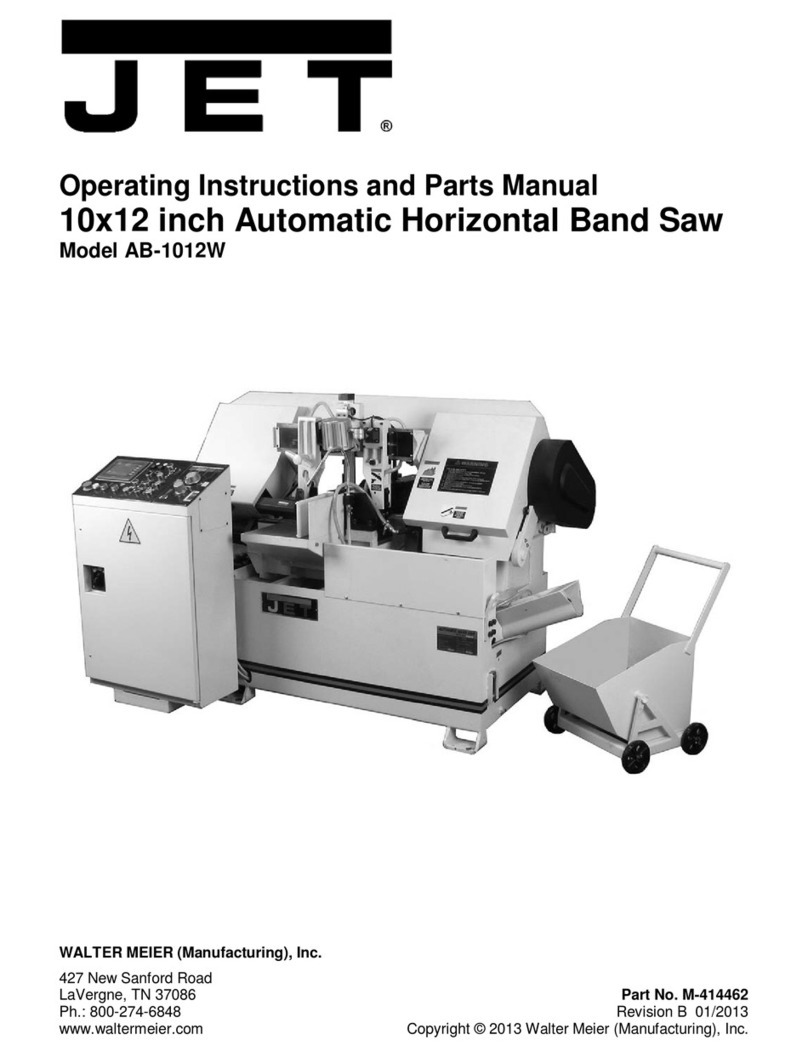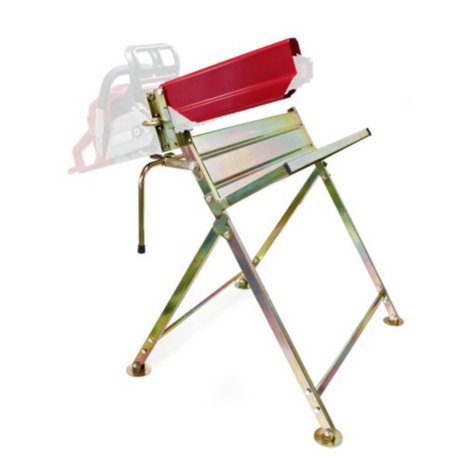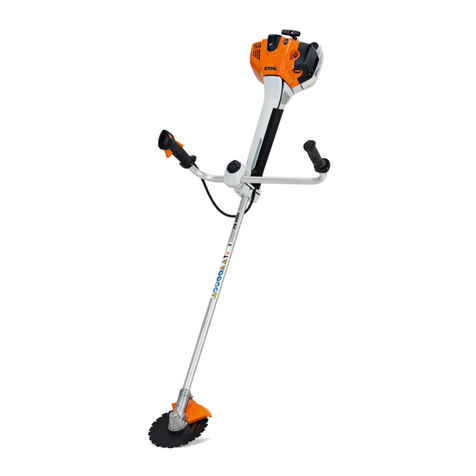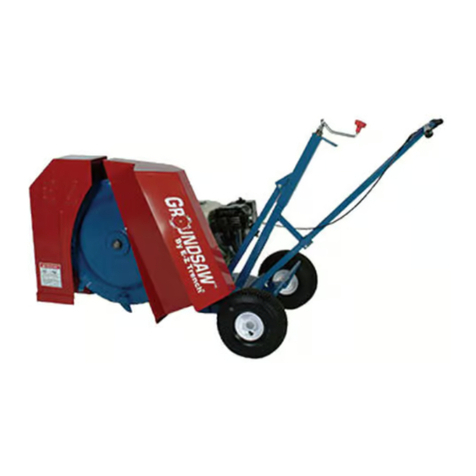Incra TS-LS User manual

INCRA
The only table saw
fence with patented
Automatic Lead Screw
Positioning ControlTM
Safety.................... 2
Fasteners and Hardware Lists. . . . 2
Rail Assembly . . . . . . . . . . . . . . 4
Base Mount Assembly . . . . . . . . . 6
Fence Assembly . . . . . . . . . . . . . 8
Final Calibration. . . . . . . . . . . . . . 9
Blade Guard Adjustments . . . . . . 11
Extension Table . . . . . . . . . . . . . 11
Auxiliary Fence Mounting . . . . . . 12
Maintenance . . . . . . . . . . . . . . . 12
Warranty................. .12
CONTENTS
Please read this owner’s manual and
keep it at hand for reference.
Note: The INCRA TS-LS system consists of
three packages. One of the packages contains
the rails and another, the base mount unit.
These two assemblies are covered fully by this
owner’s manual. The third package contains
the INCRA LS Positioner. Read all of this
TS-LS owner’s manual and the Safety, Getting
Acquainted and Operations sections of the
LS Positioner manual. If you have also pur-
chased one of the router table extension wings,
complete all assembly instructions in
this manual BEFORE attaching the
router table.
In just about an hour or so, you
are going to be operating one
of the most exciting new tools in
today’s woodshops. Your table
saw will undergo a transforma-
tion, and what was once an
average saw will emerge a preci-
sion woodworking machine, one you’ll be proud
of for years to come. So take a few minutes to
read over the safety information and mounting
instructions, then grab a Phillips screwdriver
and a set of wrenches and let’s get started
.
OWNER’S MANUAL

6 each
3⁄8– 16 x 11⁄2”
hex bolt
6 each
3⁄8”
flat washer
6 each
3⁄8”
lock washer
6 each
3/8– 16
hex nut
2 each
3⁄8– 24 x 1”
hex bolt
(Delta Unisaw)
4 each
5⁄16 – 18 x 11⁄2”
hex bolt
4 each
5⁄16”
flat washer
4 each
5⁄16”
lock washer
4 each
5⁄16 – 18
hex nut
Before using the INCRA TS-LS, read and follow all
of the instructions and safety information in this
manual.
When using the INCRA TS-LS in conjunction with
any other tool, first read and follow all instructions
and safety information in that tool’s owner’s manual.
Never let any part of the INCRA TS-LS interfere
with another tool’s safety guards or other safety
equipment.
Before using your INCRA TS-LS, make sure all
mounting screws are tight and that the black
clamping knobs are securely tightened to the rails.
Always turn off the power and make sure that the
blade is fully stationary before changing the setting
on any part of the INCRA TS-LS.
Always keep both hands behind the fence when
moving the INCRA TS-LS to a new setting.
Before making a cut, always make sure that the
carriage clamp is fully engaged and that the
rail hook thumbscrew is securely tightened.
Use appropriate safety devices. Keep hands clear
of the saw blade! Always use a push stick, rubber
soled push block, or other safety devices to keep
your hands safely away from the saw blade.
Never let the saw blade come into contact with
any part of the INCRA TS-LS or
LS Positioner.
Wear safety glasses, hearing protection, and follow
all normal shop safety practices.
Never operate your table saw without a blade guard.
SAFETY
FASTENERS (ACTUAL SIZE)
Mounting Bracket Hardware Pack B-01
Note:
Extra hardware is provided in this pack to
ensure compatibility with a wide variety of
table saws. Only four of the bolts will be
used in a typical installation.
Important safety instructions for using the INCRA TS-LS
2 INCRA Woodworking Tools & Precision Rules

6 each
3⁄8– 16 x 3⁄4”
hex bolt
6 each
1⁄4 – 20
square nut
10 each
3⁄8– 16
rectangular nut
8 each
#10 – 32 x 7⁄16”
Phillips flat head screw
8 each
#10 – 32
hex nut
Rail Hardware Pack B-02
Base Mount and Fence Glide Hardware Pack B-03
10 each
3⁄8”
flat washer
6 each
1⁄4– 20 x 1⁄2”
socket head cap screw
6 each
1⁄4”
flat washer
4 each
3⁄8– 16
dual pilot rectangular nut
4 each
3⁄8– 16 x 3⁄4”
clamping knob
4 each
3⁄8– 16 x 1⁄2”
hex bolt
8 each
#10 – 32 x 3⁄8”
Phillips pan head screw
8 each
#10
flat washer
8 each
#10 – 32
hex nut
4 each
3⁄16”
thick nylon washer
4 each
3⁄8– 16 x 3⁄8”
socket head set screw
LS Mounting Hardware Pack B-04
INCRA TS-LS Owner’s Manual 3
Note:
Each hardware pack is labeled and bagged separately.
Open each pack as it is called for in the instructions to
simplify assembly.

4 INCRA Woodworking Tools & Precision Rules
Unplug your table saw and remove the existing fence,
including the front and rear support rails, mounting
brackets, and the blade guard.
Note: The blade guard must be reinstalled after you have
nished mounting the INCRA TS-LS to your table saw.
Attach mounting brackets
Attach (4) mounting brackets to the cast iron surface
of your table saw using the supplied hardware. See Fig. 1.
The Mounting Bracket Hardware Pack B-01 contains
a variety of fasteners which will work with most table
saws. Use the largest bolts in the pack that will fit your
saw’s existing mounting holes. If the holes in your table
saw are threaded, use the fastener arrangement shown
in Detail 1A. If the mounting holes are not threaded, use
the fastener arrangement shown in Detail 1B. Position
the mounting brackets 1⁄4” below the table top as shown
in Details 1A and 1B and snug the fasteners to hold the
brackets in place. DO NOT TIGHTEN THE BOLTS AT
THIS TIME. (Discard any remaining fasteners from the
Mounting Bracket Hardware Pack B-01.)
Loosely attach rail bolts
Open the Rail Hardware Pack B-02. Add a 3⁄8” flat
washer to each of (4) 3⁄8–16 x 3⁄4” hex bolts. Place the
bolts through the holes in the mounting brackets and loosely
attach the 3⁄8–16 rectangular nuts. See Fig. 2 above.
Slide rails onto mounting
brackets and tighten bolts
Carefully slide the rails onto the mounting brackets so that
the rectangular nuts are captured in the T-slot on the bottom
of the rail. Fig. 3 shows the correct orientation for the front
and back rails. Approximately center the length of the
rails on your table saw and tighten the mounting bolts that
secure the rails to the brackets.
FIG. 1
Aach rail
mounting brackets
Use appropriate mounting
hardware from the Mounting
Bracket Hardware Pack B-01 to
aach brackets
(See Details 1A and 1B)
Rail
mounting
brackets
Threaded holes
in table saw
Lock washer
Through holes
in table saw
(Not threaded)
Flat
washer
Lock washer
Web
RAIL ASSEMBLY
DETAIL 1A
DETAIL 1B
FIG. 2
Loosely
aach rail
bolts
2
3
Orient rails so that web is vertical
and off center T-slot faces the saw
as shown below
Rear rail
Off center T-slot faces table saw Web
FIG. 3
Front and rear
rail orientation
1⁄4”
Table saw top
Table saw top
3⁄8–16 rectangularnut
Mounting
bracket
3⁄8–16 x 3⁄4” hex bolt
3⁄8”flat washer
1⁄4”
Table saw
Flat washer
Hex
nut
Front rail
1

The rail positions described above will provide support for
the base of the TS-LS for work on either the left or right
side of the blade. Left hand range is about 16” and right
hand range is 32” or 52” depending on your rail length.
If you wish to customize the setup to suit your needs, just
slide the rails left or right as necessary. Keep in mind
that sliding the rails to the right subtracts from your range
to the left, and sliding the rails to the left subtracts from
your range to the right.
Set final mounting bracket position
Clamp the (2) TS-LS base clamps to the front rail
as shown in Fig. 4 and loosen the bolts that secure the
mounting brackets to your table saw. The rail and mounting
brackets will drop down until the base clamps touch the top
of your saw, Fig. 5. This locates the final mounting bracket
position. Tighten the bolts that secure the mounting brackets
to your table saw. Repeat for the rear rail.
Mounting
bracket
FIG. 4
Set final mounting
bracket position
Base clamps
Clamp pad
Rail
Mounting
bracket
First: Clamp base clamps to rail.
Use clamp pads to avoid marring
anodized surfaces
Second: Loosen both mounting
bracket bolts. Brackets will
lower slightly
Set final rail position
Loosen the bolts that secure the main rails to their
mounting brackets and slide the rails so that they extend 45”
to the right of the saw blade (for 72”-long rails) or extend 65”
to the right of the blade (for 92” rails) as shown in Fig.6. Push
the rail against the short vertical leg on the mounting bracket
and tighten the bolts that hold the rail in place. See Fig. 7
below. NOTE: If you have also purchased a router table
extension wing, complete all assembly instructions in this
manual BEFORE attaching the router table.
4
5
FIG. 5
Tighten
mounting
bracket
bolts
Base clamp Table saw top
Mounting
bracket bolt
Mounting bracket is at
correct level when base
clamp touches table top
INCRA TS-LS Owner’s Manual 5
Custom Setups
Short vertical leg
FIG. 7
Tighten rail
mounting
bolts
Push rail against
short vertical leg
and tighten rail
mounting bolts
Rail mounting bolt
Rail
Slide stop positioner and base clamping
knob assemblies onto the rails
Base clamping knob - Add a 3⁄16” thick nylon washer to each of
(4) base clamping knobs and loosely attach a 3⁄8–16 dual pilot
rectangular nut. The flat side of the rectangular nut should face the
knob. Thread a 3⁄8–16 x 3⁄8” set screw into the remaining hole on
each rectangular nut. Slide the base clamping knob assemblies
onto the right hand end of each rail as viewed from the operator’s
side of the table saw. Do not tighten set screws or knobs at this
time. See Fig. 8.
Stop positioner - Add a 3⁄8” flat washer to each of (4) 3⁄8–16 x 1⁄2”
hex bolts, then loosely attach a 3⁄8–16 rectangular nut. Slide one
stop positioner into each end of both rails, capturing the rectangular
nut in the T-slot as shown. Do not tighten bolts at this time.
6FIG. 8
Assembly
Do not tighten
fasteners at this time
3⁄8”flat
washer
3⁄8–16 x 1⁄2”
hex bolt
Base clamping knob
3⁄16”thick
nylon washer
3⁄8–16 x 3⁄8”set screws
3⁄8– 16
rectangular
nut
3⁄8– 16 dual pilot
rectangular nuts
T-slot
Left end of rail
Right end
of rail
FIG. 6
Set final rail position
45” (72” rails)
65” (92” rails)

Attach the INCRA LS Positioner Base
to base support panel and loosely
attach remaining base clamp
Open the LS Mounting Hardware Pack B-04. Place #10
washers on each of the (8) #10-32 x 3/8” Phillips pan head
screws. Insert the screws through each of the (8) holes on the
red sub-base on your INCRA LS Positioner Base and loosely
thread a #10-32 hex nut onto each screw. Slide the hex nuts
on all (8) screws into the T-slots on the base support panel.
See Fig. 12 and Detail 12A.
Center the LS base on the support panel. (Edge of LS should
be about 11” from end of panel.) Use a square to align the
LS base at 90°to the panel and tighten
the four screws installed in the outermost
T-slots only. Do not tighten the remaining
(4) screws at this time. Slide the hex nuts
on the remaining base clamp into the
T-slots on the support panel.
4
Attach one base clamp to end of base
support panel
Open the Base Mount & Fence Glide Hardware Pack
B-03. Insert the (8) #10-32 x 7/16” Phillips flat head screws in
the countersunk holes of both base clamps and loosely thread
on the #10-32 hex nuts. Slide the hex nuts on one of the base
clamps into the (4) T-slots on the base panel, Fig. 11. Leave
about 3/8” between
the panel end and the
vertical surface on the
base clamp as shown in
Detail 11A and tighten
the screws. Set aside
the remaining fasteners
from the Base Mount & Fence Glide Hardware Pack B-03
for use in Steps 2 and 3 on page 8.
Remove
endcaps
from base
support panel
See Fig. 10 at right.
BASE MOUNT ASSEMBLY
Attach glide pads to
underside of base clamps
Peel the adhesive backing from the glide pad and adhere to
the base clamp as shown in Fig. 9. Repeat for remaining
base clamp.
Note: Do not attach glide pads until after main rail installation
has been completed. (See page 5, Figs. 4 and 5.)
1
2
FIG. 9
Adhere glide pad to
underside of base clamp
Adhesive
backed glide pad
Base clamp
FIG. 11
Aach one base
clamp to end of
base support panel
LS Positioner Base
Base support panel
Tighten outside (4) fasteners only at this time
Complete the base mount assembly detailed below before
adding fillers (table board, router tables) between the
rails.
Note: The base support panel used in the base mount
assembly is designed for use with table saws having a
front to back measurement of up to 28”. If your table saw
measures greater than 28”, a custom cut support panel is
available. For details, e-mail us at customerservice@
incra.com or call us at 972-242-9975.
Endcap
FIG. 10
Base
clamp
FIG. 12
Aach LS to base
support panel
6 INCRA Woodworking Tools & Precision Rules
#10– 32 x 7⁄16”
Phillips flat head screw
#10-32
hex nuts
Base support
panel
3
Hex nuts for screws
captured in T-slots on
base support panel
Hex nuts
captured in
T-slots
Base support panel
3⁄8”
Base clamp
Detail 12A
Base support
panel
Base clamp
Base support
panel
Machinist square
#10– 32 x 3⁄8”Phillips pan
head screws with washers
11”
Detail 11A

Set final base assembly
position
Loosen the (4) base clamping knobs and slide
the base assembly to locate the near side of
the base support panel at 37 1/4” from the
saw blade. See Fig. 14. Tighten the clamping
knobs in place. Using a 3/16” hex tool, tighten
the (4) set screws through the holes located
in the base clamps. If you have the 72” Rails,
slide the (2) stop positioners up against the
rear edge of the base clamps as shown and
tighten the hex bolts. Should you ever need to
remove the base assembly from your table saw,
these stop positioners will allow you to return to
the original setup in seconds.
92” RAIL NOTE: If you are setting up an
extended capacity system using the 92” rails,
DO NOT tighten the stop positioners just yet.
Instead, assemble the Floating Stops shown
in the TIP on page 12 and slide them up to
the front edge of both base clamps (the edge
nearest the blade) and tighten in place. After
completing all of the setup and calibration
instructions from this manual, refer to the
“EXTENDED CAPACITY INSTRUCTIONS”
included in the 92” Rail box to complete your
setup.
6
Align base mount assembly
parallel to miter slot
Take the base mount assembly to the table
saw and, as you lower the base mount onto the
rails, position the (4) clamping knob assemblies
directly under the slots in the base clamps.
Slide the base assembly along the rails to
position the base support panel at 20” from
the miter slot, Fig. 13. Take a measurement
at both ends of the panel. Loosen the Phillips
head screws that hold the base clamps as
necessary to align the panel parallel to the
miter slot. Tighten all (8) screws that secure
the base clamps to the base support panel.
Replace the base support panel end caps.
FIG. 14
Set final base assembly position
Base clamp
First: Slide base assembly
to 371/4”from saw blade and
tighten all (4) clamping knobs
3⁄16”hex tool
INCRA TS-LS Owner’s Manual 7
5FIG. 13
Align base mount assembly parallel to miter slot
Loosen base clamp
screws as necessary
Base clamp
Base support
panel
Third: Tighten base clamping knobs and
all (8) screws that secure the base
clamp to the base support panel
Miter slot
By loosening the (4) clamping
knobs and set screws, you can
slide the base assembly to any
position along the length of the rails
- great for accessing a router table
extension wing placed to the left of the
blade.
Replace
end caps
First: Lower base
assembly onto rails
and base clamping
knobs
Second: Slide base assembly
to align 20” from and parallel
to miter slot
Base
clamping knob
Third: Slide stop positioners up to
both base clamps and tighten hex
bolts (72” rails ONLY). See note at
left if you have the 92” rails.
Second: Tighten (4) set
screws through holes in
base clamps
Note: This
alignment is a
“rough” preliminary
only. Final fence
alignment is
covered later in
this manual
20”
371/4”

Important:
If you have not already done so, read the
Operations section of your INCRA LS Positioner manual
to familiarize yourself with the clamping and micro adjust
functions of the LS before continuing.
Slide carriage into LS Positioner Base
Slide your LS Positioner’s carriage into the LS Base and
position the fence mounting bracket approximately in line with
the two nearest rail mounting brackets. Lock the carriage in
place. See Fig. 15.
Loosely attach TS-LS fence
Place a 1/4” flat washer on each of (2) 1/4-20 x 1/2” socket
head cap screws and insert the screws through the slotted
holes in the back of the fence mounting bracket. Loosely
attach the 1/4-20 square nuts to the screws, then slide the
upper T-slot on the fence onto the square nuts as shown in
Fig. 16. Position the end of the fence nearest to the operator
about 31/2” in front of the table’s edge. Do not tighten the
fence mounting screws at this time.
Attach fence glides
Place one of the supplied 3/4x 3” cardboard spacers
under each end of the fence as shown in Fig. 17 and attach
the two fence glides to the lower T-slot on the rear of the
fence using (4) 1/4-20 x 1/2” socket head cap screws, 1/4”
washers and 1/4-20 square nuts. See Detail 17A. The glide
with the black thumbscrew mounts on the operator’s side of
the saw. Align the glides flush with the rails before tightening
the fasteners. Remove and save the cardboard spacers.
Tighten fence mounting screws
Unlock the carriage and slide the fence to within about
4” from the LS base and clamp the carriage in place. Make
sure the fence glides are still aligned flush with the rails,
then tighten the two fence mounting screws. Take care not to
raise or lower the fence mounting brackets as you tighten the
screws.
Engage anti-lift rail hooks
With the carriage clamp still locked, turn the black
thumbscrew on the front fence glide counterclockwise to lower the
rail hook into the T-slot on the rail. Look into the T-slot as you lower
the hook. When the hook passes the lip on the T-slot, slide the black
thumbscrew toward the table saw to position the hook under the lip.
See Fig. 18. Now turn the thumbscrew clockwise to raise the hook.
The hook can be adjusted to limit fence lift by turning the thumbscrew
clockwise. During cutting operations, always tighten the
thumbscrew in addition to locking the carriage clamp to provide
absolute lockdown of the fence position.
To engage the rear rail hook, walk to the rear of the saw and, using a
3/16” hex tool, lower the hook into the T-slot on the rail. Slide the
fastener back to position the hook under the T-slot lip, then turn the
fastener clockwise to adjust the lift limit. Allow the fence to lift no more
than 1/32”. It is not necessary to tighten the rear rail hook before
making a cut.
FENCE ASSEMBLY
1
2
3
4
5
FIG. 15
Slide LS carriage
into base
Rail mounting
bracket
Position fence mounting
bracket approximately in line
with rail mounting brackets
and lock carriage in place
FIG. 16
Loosely aach TS-LS fence
1⁄4- 20
square nut
TS-LS
fence
1⁄4” flat
washer
1⁄4- 20 x 1⁄2”
socket head
cap screw
FIG. 17
Aach fence glides
DETAIL 17A
FIG. 18
Engage
anti-lift rail
hooks
Thumbscrew
Rail hook
NOTE: When removing the TS-LS from your
table saw, always disengage the rail hooks from
the T-slot lip before lifting the TS-LS off the rails.
CAUTION: Never adjust the rear rail hook by reaching over
the saw. If an adjustment must be made, turn off the saw and
walk to the rear to make the adjustment.
1⁄4–20x1⁄2”
socket headcapscrew
Fence mounting
bracket
Fence mounting bracket
LS Carriage
1⁄4–20
square nuts
8 INCRA Woodworking Tools & Precision Rules
Fence glide
Rail
Second:
Aach
fence glidesCardboard
spacer
Fence glide First:
position
cardboard
spacers
1⁄4“Flat
washer
LS Base

FINAL CALIBRATION
Important: As with any table saw fence,
accurate calibration and alignment require
that the saw blade be aligned parallel to the
miter slot. If you are uncertain about your saw
blade/miter slot alignment, consult your table
saw’s owner’s manual for information on how
to check and set this important alignment.
Calibration –
Right side of saw blade
Align fence parallel to
miter slot and tighten
LS Base mounting screws
Unlock the carriage clamp, then slide the fence
up to the nearest miter slot and clamp in place.
Loosen the (4) screws that secure the LS
Positioner’s red sub-base to the base support
panel and align the fence parallel to the miter
slot. See Fig. 19. Make sure during this
alignment that the fence glides remain flush
with the rails. Now tighten all (8) fasteners to
secure the red sub-base to the base support
panel.
Important: If it becomes necessary to realign
the fence in the future, make sure to loosen all
(8) base mounting screws.
Zero fence to saw blade
With the table saw unplugged, raise the
saw blade about 2” and slide the fence forward
until just before it contacts the blade (to within
less than 1/32”). Place your LS Positioner in
the micro adjust mode as described in your
LS owner’s manual and micro adjust the fence
forward until it “kisses” the saw blade, Fig. 20.
Lock the carriage in place.
Note: After micro adjusting, re-zero the
scale on the micro adjust knob by rotating the
scale (not the knob) to move the zero back to
alignment with the red pointer.
Set scale position
With the LS still locked at the “zeroed”
position set above, lift one end of the stainless
steel scale from the magnetic track and slide
the scale to position 0” under the hairline
cursor, Fig. 21. Lower the scale back onto the
magnetic track. If you want, you can also slide
the lexan scale to agree with the stainless steel
scale.
1
2
FIG. 19
Align fence parallel to miter slot and
tighten LS Base mounting screws Mounting
screws
Second: Loosen all
LS Base mounting
screws, align fence to
slot, then retighten
screws
First: Slide fence up to
nearest miter slot and clamp
in place
FIG. 20
Zero fence to saw blade
First: Slide fence forward to within
less than 1⁄32” from saw blade
Second: Micro
adjust fence
forward until
fence “kisses”
the saw blade,
then lock the
carriage in place
With fence zeroed
to the blade, slide
the stainless steel
scale to position
the 0” mark under
the hairline cursor
3
INCRA TS-LS Owner’s Manual 9
FIG. 21
Set scale
position
Saw blade
Fence
0
124 24
16
8
8
16
8

Calibration –
Left side of saw blade
Moving your TS-LS to the left side of the blade can be quite
useful, especially on table saws which have a blade tilt to
the right. This feature makes bevel cuts on opposing edges
of a panel safe and easy since the blade tilts away from,
rather than toward, the fence. The setup is easy.
Note: If your table saw blade tilts to the left, calibration on
the left side of the blade is not necessary.
Reverse LS position and slide to left
end of rails
Loosen the (4) base clamping knobs and the (4) set screws
that secure the base assembly to the rails and slide the
entire base assembly and the LS to about mid-length along
the rails. Lift the base assembly and the LS off of the rails.
Turn the base assembly and the LS so the fence faces the
opposite direction and place back onto the rails. (Remember
to always disengage, then re-engage the fence hooks when
converting to left hand usage.) Continue sliding the unit
to the left to position the base assembly about 1” from the
ends of the rails. Tighten the clamping knobs on the rear
rail only. Fig. 22. The two stop positioners installed earlier
should be located at the end of the rails.
Align fence parallel to miter slot
and tighten clamping knobs and set
screws
Unlock the carriage and slide the fence to the miter slot on
your table saw. Align the fence parallel to the miter slot by
shifting the base clamp on the front rail. Once the fence is
set parallel to the miter slot, tighten all base clamping knobs.
Then, using a 3/16” hex tool, tighten the (4) set screws
through the holes located in the base clamps, Fig. 23.
Zero fence to left side of saw blade
Unlock the carriage and move the fence to within less
than 1/32” from the saw blade. Place the LS in micro adjust
mode and micro adjust the fence forward until it “kisses” the
saw blade, Fig. 24. After micro adjusting, release the micro
adjust lever and lock the carriage in place.
Note: Whenever you return the LS to operation on the right
side of the blade, remember to micro adjust the fence back
to a zero reading on the micro adjust scale.
Set scale and stop positions
Slide the extra (0-16”) scale in the scale slot and
position the 0” mark under the hairline cursor. Now slide the
(2) stop positioners up to the base clamps and tighten the
hex bolts. Once these stops are set, you’ll be able to return
easily to your left hand setup anytime, Fig. 25.
Important: With right and left calibrations now complete,
reinstall blade guard and all safety equipment removed
previously. Raise the saw blade and tilt to 45º to check
for clearance between the blade guard and the rear rail
assembly. If the rear rail interferes with the blade guard,
you must follow the instructions set out in the Blade Guard
Adjustments section of this manual.
FIG. 22
Place LS Positioner on the
rails to the left of the saw
First: Locate LS
Positioner about
1
”
from left end of rails
Second: Tighten knobs
on rear rail only
1
2
3
4
FIG. 23
Align fence parallel
to miter slot
and tighten base
clamping knobs
and set screws
Shift this base
clamp to align
fence with
miter slot, then
tighten clamping
knobs and
set screws
These knobs
already tightened
FIG. 24
Zero fence
to left
side of
saw blade
First: Slide fence to within less
than 1⁄32” from saw blade
Second: Micro
adjust fence
forward until
fence “kisses”
the saw blade,
then lock the
carriage in
place
FIG. 25
Set scale
and stop
positioners
Slide stop
positioners
to edge of
base
clamp
and
tighten
hex bolts
Slide extra scale to read
0
”
under hairline cursor
Set screw
access holes
10 INCRA Woodworking Tools & Precision Rules
1
”
Stop
positioner
Hex tool
Fence Sawblade

If you wish to add a 3/4” thick table board between the
right hand extension wing of the table saw and the TS-LS
base mount assembly, begin by making two of the wooden
supports like the one shown in Fig. 28. For the length of
the support, measure the distance between your extension
wing and the base mount assembly. Loosely attach the
fasteners through the holes in the supports. Remove the
base assembly from your saw, then slide the square nuts
into the inside T-slots on each rail, Detail 28A. Cut a table
board to fit and screw to the supports. The oversize holes
in the support should allow range for positioning the table
board flush with your table saw top.
If, after reinstalling the blade guard and tilting the motor,
you find that the rear rail interferes with the blade guard,
you must add the two remaining rail mounting brackets
and split the rear rail to provide the necessary clearance
as shown in Fig. 26. Begin by removing the base mount
assembly. Loosen the bolts that secure the rear rail to
the existing brackets and slide the rail off. Reinstall the
blade guard, then locate the positions for the additional rail
mounting brackets on either side of the blade guard. The
mounting brackets should be placed as close as possible
to the blade guard, but before drilling the mounting holes,
make sure to check the positions for clearance when the
blade is tilted to 45º. When you have found the mounting
bracket locations, drill a 3/8” diameter hole in the center of
each position. The center of the hole should be about 11/8”
below the table top.
Remove blade guard, then using 3/8-16 x 11/2” hex bolts,
nuts and washers, attach the extra mounting brackets
loosely in place. Install the rail bolts as shown in Fig. 2 on
page 4, then slide the rear rail back into position. Tighten
all rail mounting bolts, then tighten the two bolts that secure
the brackets to your table saw. Use a hacksaw to make
a cut through the rear rail about halfway between the two
additional rail mounting brackets. Loosen the bolts that
secure the rails to the brackets and slide the rails to create
an opening large enough to reinstall the blade guard. See
Fig. 27. Again, tilt the blade to 45ºto check for clearance.
Once the rail positions are established, sand or file the cut
ends of the rails to remove any sharp edges. Tighten the
bolts that secure the rails, then repeat the alignment and
calibrations starting with Step 6 on page 7.
BLADE GUARD ADJUSTMENTS
FIG. 26
Rear rail modification
Two rail mounting
brackets are used
on each side of blade
guard to provide
support for split
rear rail modification
Blade guard
FIG. 27
Cut through rear rail
between additional mounting
brackets and separate the two rail
sections to create opening for blade guard
EXTENSION TABLE
FIG. 28
Table board support
Note: Above dimensions are for
a 3⁄4” thick table board. Adjust
hole position for different table
board thickness
DETAIL
28A
Aaching
table
board
support
15⁄32”
3⁄4”
3⁄8” dia. hole
For length, measure
distance between
extension wing and
base assembly
Fasteners required:
(4) 1⁄4– 20 x 1” hex bolts
(4) 1⁄4” flat washers
(4) 1⁄4– 20 square nuts
13⁄4”
INCRA TS-LS Owner’s Manual 11
Additional rail
mounting brackets

AUXILIARY FENCE MOUNTING
For some cutting operations, you may wish to add a wooden
auxiliary fence to the front face of your TS-LS fence. A
T-slot is provided for mounting the auxiliary fence using
1/4-20 mounting screws, washers, and hex nuts. Drill and
counterbore your wooden fence to recess the screw heads
and capture the nuts in the T-slot as shown in Fig. 29. Hole
centers should be located 13/4” from the bottom edge of the
wooden fence. T-slots in the top of the fence are provided to
attach hold downs or other user-made fixtures. Use 1/4-20
fasteners and hex nuts for these T-slots as well.
Made in America by:
Taylor Design Group, Inc.
P.O. Box 810262
Dallas, Texas 75381
Tel: (972) 242-9975
Fax: (972) 243-4277
Web Site: www.incra.com
Printed in the U.S.A. © 2003 Taylor Design Group, Inc. INCRA is a registered trademark of Taylor Design Group, Inc.
FIG. 29
Auxiliary fence mounting
Wooden auxiliary fence
1/4” flat
washer
1/4– 20
screw
1/4–20
hex nut
WARRANTY
Taylor Design Group, Inc. warrants this product for one year from date of purchase. We will repair any defects due
to faulty material or workmanship, or at our option, replace the product free of charge. Please return the failing
component only, postage prepaid, along with a des cription of the problem to the address below. This warranty does
not apply to parts which have been subjected to improper use, alteration, or abuse.
MAINTENANCE
Your TS-LS is designed to give many years of virtually
maintenance-free operation. In fact, just keeping your
TS-LS clean is all you need to do to keep the tool in top
shape. Occasionally, remove the carriage from the base
and brush or blow out any sawdust or debris that may
have accumulated. Use a toothbrush to clean the teeth on
the lead screw on both the carriage and the base. A light
application of paste wax to the top of the rails from time to
time will keep the rails smooth and clean.
10/12
Included with your TS-LS package you’ll find
the Floating Stop Hardware Pack B-05. These
stops mount to the bottom T-slot on the rails and are
used when you want to set stop positions for the base
assembly anywhere between the fixed left or right hand
stops located on the sides of the rails.
One reason for a mid-range stop position might be to
provide a single position for the base assembly where
one could access both the saw blade and the left hand
router table extension wing. Such a setup would provide
about 15”-16” of range at the table saw function and
up to 30” of travel for the router function. To install the
stops, place a washer on each end of the (2) 3/8-16 x
1/2” hex bolts. Insert the bolt through the hole in the stop
and loosely thread on the rectangular nut. Slide the nut
into the bottom T-slot from the right end of each rail. See
Fig. 30. After positioning the LS along the rails at the
desired location, slide the floating stops up to the base
clamps and tighten the bolts.
Once positioned, you
can still slide the base
assembly past the stops
if necessary by first
disengaging the fence
hooks and loosening the
(4) base clamp knobs, then
lifting the base assembly
just enough to clear the
stops as you slide the
base assembly forward or
backward.
FIG. 30
12 INCRA Woodworking Tools & Precision Rules
Floating Stops
Floating
stop
3/8– 16
rectangular
nut
Right hand
end of rails
3/8” flat
washer
3/8-16 x 1/2” hex bolt
13/4”
Other manuals for TS-LS
1
Table of contents
Other Incra Saw manuals
Popular Saw manuals by other brands

Chicago Electric
Chicago Electric 65570 Owner's manual & safety instructions

DeWalt
DeWalt DW728 instruction manual

Milwaukee
Milwaukee M18 FBS85 Original instructions
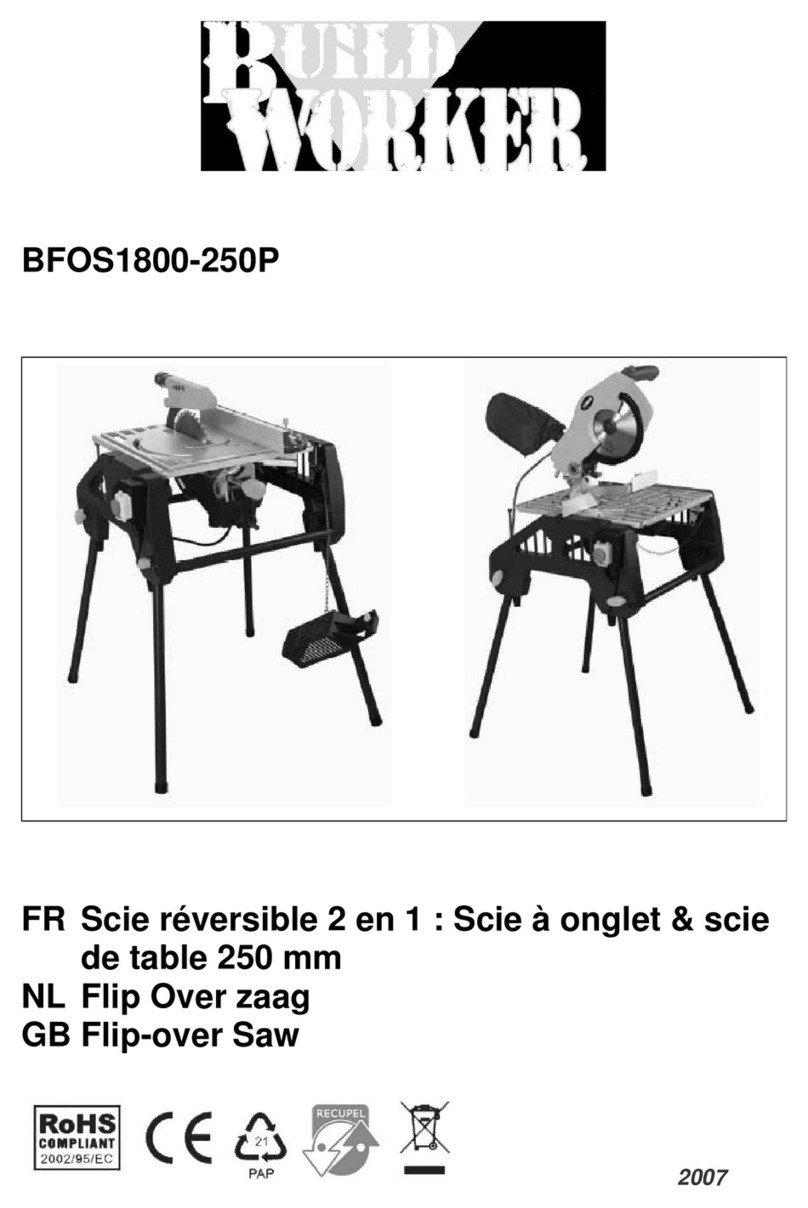
Build Worker
Build Worker BFOS1800-250P manual

Shindaiwa
Shindaiwa EC7500 Owner's and operator's manual

Batavia
Batavia BT-CS009 operating instructions
